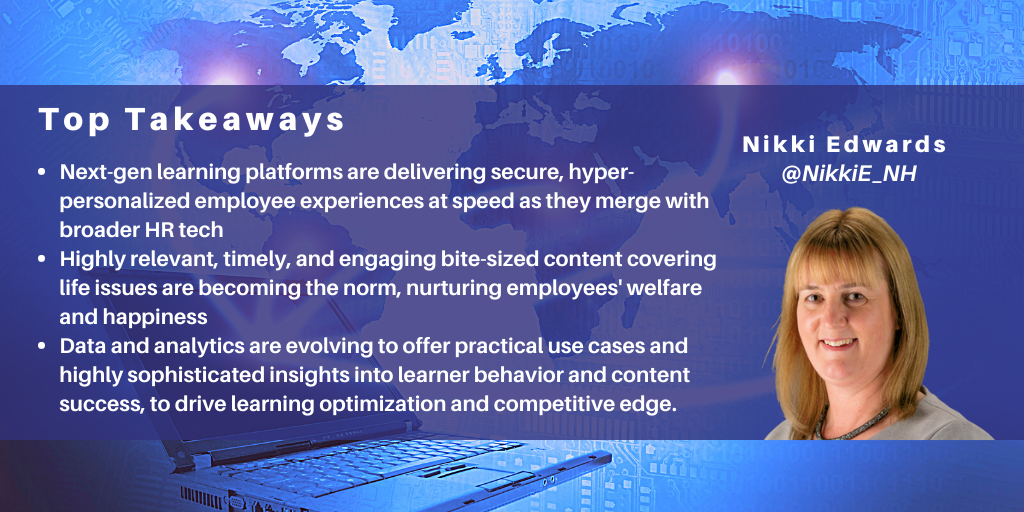posted on Oct 18, 2022 by Nikki Edwards

The 2022 Learning Technologies Autumn Forum (at the London ExCel, October 13) reflected the market changes and global events that have been driving the learning transformation agenda since early 2020. Remote and hybrid working demand and deepening talent and skills shortages have seen learning become a C-suite priority: organizations realize that if they cannot buy or borrow talent (via permanent or temporary hiring), they must build it through learning.
Job seekers, candidates, contractors, and employees want a fast, consumerized experience in both their private and work lives. Furthermore, if a prospective or current employer fails to provide ongoing development opportunities, employees will likely look elsewhere. Add in the current economic pressures and impact on people's well-being at work, and this makes for a highly challenging 2023.
Learning tech vendors and tech-savvy CLOs have been driving the digital learning agenda for years, and the current market challenges mean their business strategies are cut broader and deeper than before. Some core themes remain on the agenda, several of which were showcased by vendors attending the forum: next-gen platforms, upskilling/career pathing, optimized bite-sized learning, and data/analytics.
Next-gen platforms
Several vendors have made acquisitions to create next-generation platforms that will be fit-for-purpose in 2023+, taking the best features and functionality of their acquired tech. Cornerstone's 2022 acquisition of EdCast (along with previous investments) will see the best aspects of all the platforms in its portfolio come together in 2023; while LTG's platform and services portfolio, assembled over the past decade from multiple acquisitions, will continue to integrate. Both these vendors are driving enhanced learner/employee experiences.
Huler's HulerHub personalized employee experience platform layer links to an organization's tools, documents, and systems. HulerHub provides a straightforward Netflix-style interface that is quick and easy to update without coding or design expertise. The platform is carefully designed to avoid common pitfalls. For example, pre-boarding maximizes communication, while onboarding aims to prevent digital overload. Similarly, maintaining a good work/life balance is vital while giving the freedom for growth and development.
Sponge's Spark LMS uses facial recognition technology, which is invaluable for attendance monitoring in environments where fraudulent attendance is commonplace. The technology also highlights learners' boredom, confusion, or delight when accessing learning content.
Upskilling/career pathing
Several vendors, such as Cornerstone and LTG, are developing skills ontologies. These enable learners to close their skills gap through AI-driven learning opportunities and map out career paths to facilitate talent mobility. Learning Pool has just acquired People-Analytix AG, an AI-based employee skills management platform. The platform includes a proprietary multilingual skills ontology with over 20,000 skills, enabling companies to identify organizational skills gaps, uncover workforce trends, and match employees to jobs, projects, and learning. The plan is to roll out an enhanced offering now that the two companies have come together.
With its established Saffbot learning chatbot (that supports learners beyond formal training as they interact with content in real-time), Saffron Interactive launched its new AI-enabled skills coach Aida at the event.
Optimized bite-sized learning content
Learning is increasingly geared around busy lives, with bite-sized or microlearning opportunities accelerating. Several learning tech vendors operating in the education space (e.g. D2L, Frog), with deep insights into the pedagogy of learning, are emerging in the corporate arena to maximize learners' learning capacity in short bursts.
More vendors are developing their platforms with authoring tools to encourage self-created content. This option works well where organizations have company-specific information to share with their workforces that cannot be curated from a third-party provider. For example, Rise Up has fully integrated its proprietary LMS with MS Teams, enabling learning to take place in the flow of work.
However, not all organizations want to create content, preferring to use third-party providers who curate or create content for their clients. Content providers are broadening their content portfolios, making highly-relevant, timely, and engaging content. For example, Thrive provides content via its Content Club for any LMS. It has recently added content around themes such as World Mental Health Day, the cost-of-living crisis, financial well-being, and the menopause. Its catalog has a section devoted to hot topics. HowNow handpicks specialist content for its HowNowPlus offering and partners with several curated content providers.
Numerous learning techs focus on a specific learning modality (e.g. video, animation, VR/XR) geared for consumerized learning, and it was evident that appified video platforms for employee-generated content are increasing. For example, StoryTagger provides an easy-to-use app with templates for uploading work-related content in bite-size chunks, enabling learners to choose a top-level overview or dive into the details. iAM Learning uses animation for off-the-shelf and bespoke content, using story-telling to engage learners and help them retain knowledge. ARuVR (formerly VRtuoso) offers an XR Authoring System, XR Real-Time Sessions, and XR Interactive Live Streaming under one enterprise-grade platform. In-house L&D teams can add their own XR content without needing XR expertise.
Data/analytics
Sponge claims that 90% of executives say that developing employees is very important to their businesses, yet only 12% of CFOs are confident that L&D is spending the right amount of money in the right places. Evolving data maturity from being data-aware to data-driven, and building actionable insights from learning data, helps organizations to invest where they need and drive optimal business outcomes and ROI. All vendors provide learning data and reporting/analytics. Companies need to recognize the value of the resultant insights and embrace them.
Some of Sponge's standout features include detailed analytics on learners' quiz/exam behaviors: for example, seeing how much time they took to read, analyze, and answer a question or which question gave them the most difficulty. Sponge can track learner engagement by highlighting which elements or modules learners breezed through and where they struggled or lost focus.
Summary
As 2023 approaches, and with so many external challenges in play, organizations must put their workforce first and give people opportunities to grow and develop throughout their career. With the support of learning tech vendors, companies can quickly and positively impact their learners, driving workforce satisfaction, engagement, and loyalty.
